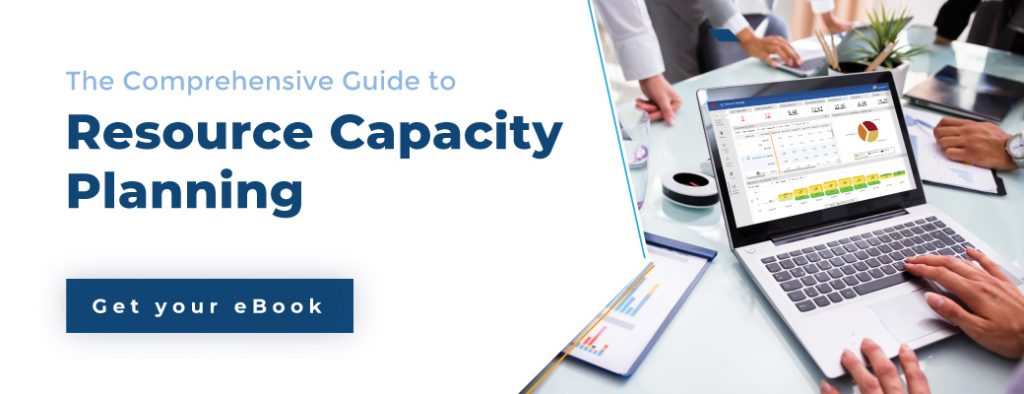Businesses are facing a highly competitive and volatile market demand across the globe. Resource costs are one of the most expensive entries in any organization’s balance sheet. So, a modern business must utilize its scarce resources most efficiently and get the best value.
Many organizations do not have a dedicated resource capacity management tool. They have been carrying out capacity planning using their legacy systems, such as excel spreadsheets/other home-grown applications. There are many resources, and no such mechanism exists to link their work together to get enterprise-wide visibility for resources.
The excel spreadsheets and half-baked home-grown capacity planning solutions are incredibly limiting, time-consuming, hard to maintain. It cannot meet new business challenges.
Businesses are in desperate need of an enterprise-level matured resource capacity planning solution. This guide has been designed for businesses to get a comprehensive understanding of enterprise resource demand and capacity planning. It will help any company to establish the right processes with the tool.
1. What is Resource Capacity Planning?
Resource capacity planning is the process of forecasting the gap between future capacity and demand to identify the shortfall/excesses of resources. It helps take corrective actions ahead of time for successful project delivery and optimizes the utilization of every resource across the organization.
Resource capacity planning requires centralizing information from various systems. These systems are human resources, skills, current projects, future pipeline projects, resource demand/ allocation, vacations, and non-project activities. It helps you build a single real-time system as a single source of truth.
2. The role of Resource Capacity Planning in project management
Resource Capacity planning plays a vital role in project management. It helps align the sales and delivery by planning and forecasting pipeline opportunities. Once a pipeline project reaches a certain probability stage, the project manager estimates the resource requirements and initiates the requisition process. The corresponding resource manager then starts planning for fulfillment. But first, he/she needs to analyze if there are sufficient resources to start the project.
The resource manager compares the existing resource capacity against the project demand from multiple perspectives such as role, department, team, skills, and more. It helps to identify the shortages or excesses ahead of time. Accordingly, managers can apply appropriate resourcing strategies to bridge this gap, such as hiring permanent or contingent workforce.
Allowing sufficient lead time helps avoid last-minute hiring/firing costs and ensures that the right resources are available at the right time and cost for projects. Simultaneously, capacity planning helps minimize bench time proactively using on-the-job training, adjusting timelines, or selling excess capacity.
In a nutshell, Resource Capacity planning helps build an optimized project team, reduces project costs, and future proofs the workforce against market volatilities and economic uncertainties.
3. What Are the Business Benefits of Resource Capacity Planning?
Reduce Project resource Costs Across the enterprise
With the help of efficient capacity planning strategies, overall resourcing cost can be reduced drastically:
- Eliminate under/over skilled resources on projects
- Utilize cost-effective global resources without compromising quality
- Avoid last-minute hiring cost with proper capacity planning
- Minimize hiring/firing cycles by aligning project workload with workforce capacity
- Avoid Double Booking of Resources and minimize burn rate
- Control unplanned attrition
Maximize productive utilization of the workforce.
The capacity planning system forecasts billable and strategic utilization of the workforce ahead of time. It will help you mobilize employees from non-billable or low-priority work to billable or high-priority projects. Billable utilization is a critical KPI for a professional service business to ensure profitability and sustainability.
Ensure competent resource allocation for successful project execution
Having the right employee with the right skills and cost is crucial for a project to finish within budgeted time and cost.
The resource planning and management system must identify and allocate competent resources. It is based on their skills, experience, qualifications, location, team, resource cost rate, and any other criteria you prefer. One must avoid the “first visible first fit” approach instead of the “best visible best fit” principle for resource allocation.
Forecast and bridge the skills gap
Capacity planning can help you identify skill-shortage ahead of time so that you can take corrective action:
- Adjust project timelines to align with available capacity.
- Retrain and skill up available employees ahead of time.
- Hire a contingent workforce before time.
- Optimize Bench Management
- Bring forward initiatives to meet strategic goals.
- Allow movement of resources across departments to maximize utilization
Align Sales and Delivery by Forecasting Pipeline Opportunities
Capacity planning enables the sales team to estimate and forecast demand for various resources based on the sales pipeline opportunities. It helps the delivery team ensure that the right resources are available at the right time to finish the project.
4. Best Practices of Resource Capacity Planning
Resource capacity planning is becoming increasingly critical for a business to reduce resourcing costs and become responsive to the market. As a result, the concept of capacity management has gone beyond the basics of measuring the demand against capacity.
Following are some of the best practices in this area: –
Forecast capacity vs. demand and form a project resource plan in advance
A business must forecast capacity vs. demand from multiple dimensions, i.e., by role, department, team, location, skills, etc. It helps in identifying short or long-term shortage/excess of resources ahead of time. It also allows people with different roles to view their specific information at the right time, which helps in decision-making.
Using the capacity vs. demand report, managers can proactively implement the right resourcing treatments and form a full-proof project resource plan ahead of the curve.
Track and analyze competency matrix in real-time
It is critical to track and keep up-to-date information about the competency and workforce. It allows the right resource with skill, experience, qualifications, individual preferences, etc., to be allocated to the proper work.
It helps plan a new project that may need a niche skill that is difficult to get from the market. If such a capability is available within the organization, the concerned person can be out rotated with a suitable backfill candidate.
Manage project pipeline efficiently
The system should keep track of future potential projects in the pipeline and forecast estimated resource demand. It will ensure that the resource pool is optimally balanced, skilled, and ready to meet new projects’ demands.
One can decide if there is a need to re-skill, hire, or contingency resources to do the work. It helps in planning the resource mix.
Predict and improve overall resource utilization
The system should provide short or long-term forecasting of billable, strategic, and overall utilization. It helps in taking corrective actions to ensure high utilization and protect the business’s profitability.
Foresee Project vacancies and people on the bench
The system should get you foresight into future resource needs and people who will end up on the bench. It helps the resource manager to mix and match available people against project vacancies. It will be an opportunity lost if you cannot find the right resource at the right time for the right project.
Streamline Resource Requisition to deliver projects on time
Generally, resource requesting and allocations are done through email or phone requests. It causes quite a bit of chaos. It is critical to streamlining the process using workflow, ensuring resources are allocated with appropriate approvals and notifications. One must avoid using unnecessary emails/telephone calls as they cannot be easily reconciled, documented, and analyzed later.
5. How to Choose the Right Solution for Efficient Resource Capacity Planning?
Capacity planning is a crucial part of the performance improvement of modern business. It is critical to look for a solution beyond the current spreadsheet functionalities. A business should ensure that they have a solution that can provide the following:
The system should be scalable, configurable, and expandable
Every business is different, so are their resource capacity planning needs. A business must select a scalable and configurable tool to meet current needs and expandable to meet future business requirements. System performance must not degrade with more users using the tool across the organization.
It should forecast profitability and productivity
Resource capacity planning methodology should help your business to do multi-dimensional forecasting. It will provide real-time business intelligence to improve business performance, profitability, and productivity.
It must solve the complexities of matrix organization
It must align with the matrix organization structure. Nowadays, most businesses have established a matrix organization structure to achieve the best utilization of their resources. So, companies must have a capacity planning tool that aligns with matrix organization structure and associated complexities.
The solution must provide real-time BI analytics
Resource demand in a real-life business environment changes every minute. So, it is crucial for capacity planning techniques to get real-time business intelligence, i.e., reports, analytics, and dashboards.
It should integrate with other applications
Most businesses have already invested in enterprise-level systems. They are holding quite a bit of data required by a capacity planning solution, i.e., resource profile, competencies, project detail, etc. So, the resource management system must integrate seamlessly with existing applications.
6. Checklist for Resource Capacity Planning for a Specific Period
Forecast Calculate Workforce Capacity
- Take an inventory of your organization’s full-time, part-time, contractor, or freelance resources.
- Include resources who will be joining or leaving during this period
- Assign calendar (Workweek and Holiday list) to your resources if they are working at different locations
- Track the skills and competencies of the selected resources
Establish Project Portfolio
- List down all the current and future projects.
- List down all the potential opportunities which are in the pipeline.
- Account for non-project activities like BAU, Support Maintenance, Administrative Work, Training, etc
- Categorize the projects into Billable, Strategic and Non-Billable Projects
- Prioritize your projects for better Capacity Planning
Forecast Resource Demand
- Get foresight into the resource requirements of the pipeline projects.
- Identify the competent resources and their availability during the same timeline.
- Prioritize the demand as per the criticality of each project and their subsequent tasks.
Compare Resource Demand against Capacity
- Analyze Resource Capacity versus Demand
- Identify the Gap between Resource Capacity and Demand
- Identify skill shortages or excesses, if any.
- Plan on how to bridge the gap of shortfall of resources ahead of time
Allocate resources to the appropriate projects
- Assign the right resources to the right Project. Avoid allocating over-skilled or under-skilled resources.
- Allocate generic resources or placeholders on future Projects.
- Create estimates using place holders for your Opportunities
- Record resources unavailable time, i.e., People going on Leave, training, etc.
- Implement the right resource optimization technique to avoid employee burnout.
7. The Glossary
8. The SAVIOM Solution
SAVIOM is the market leader in providing an Enterprise Resource Capacity Planning solution. With over 20 years of experience leading the market, Saviom is actively used by over 15 highly-esteemed global companies worldwide. The tools within the suite include project portfolio management, professional service automation, and workforce planning software. Re-engineer operational efficiency with a system shaped around your business!

















